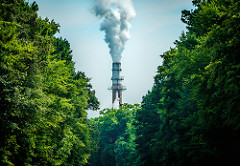clear
What are the main Greenhouse gases and how are they contributing to climate change?
clear

source:
Bill Dickinson / Flickr
The main greenhouse gases, their parts per million (ppm) in the atmosphere and their percentages of the atmosphere are as follows:
Apart from water vapour the other greenhouse gases represent just over 0.04% of the atmosphere.
Even including water vapour the atmosphere is 95% non-greenhouse gas.
Laboratory experiments with a CLOSED system show that CO2 will produce a blanket effect and reduce heat loss. The problem is that the Earth’s atmosphere is not a closed system. So laboratory results do not mirror reality.
CO2 is essential for life, it is not a pollutant. All animals, including humans, exhale CO2. Plant life NEEDS CO2 to survive.
Reconstructions of past climates show that the Earth has been through many climate regimes – from tropical to ice-age and everything in between.
Nobody can explain why these changes happen.
There are many theories but the number of variables is huge and includes – heat from the sun (this goes in overlapping cycles of different lengths), volcanic activity, the Earth’s non-circular orbit around the sun, the tilt of the Earth’s axis towards the sun, atmospheric composition (including naturally occurring greenhouse gases), continental drift, the gravitational effect of the moon on ocean circulation, the Earth’s albedo (reflectivity of radiation – e.g. the albedo of clean ice is high, that of black lava is low) … And these interact with each other in indeterminable ways.
Several theories propose that the Earth has a natural thermostat. E.g. – suppose the climate is stable, but suddenly a volcanic eruption spews so much into the atmosphere that energy from the sun cannot reach the earth’s surface, and so the temperature drops. The water vapour in the atmosphere condenses and falls as rain or snow. Ice packs form/grow. Cloud cover decreases. Eventually the thinning cloud cover allows heat to reach the surface. The planet warms. Ice melts and becomes water vapour. Clouds form, the temperature drops… But nobody KNOWS.
So it is impossible to say whether, or by how much, greenhouse gases affect the climate.
 0
0
clear
It is essential that we consider nitrous oxide when discussing greenhouse gases; it's one of the biggest factors that contributes to global warming. Nitrous oxide is "emitted during agricultural and industrial activities, as well as during combustion of fossil fuels and solid waste." These are all human-found activities that have, as a result, caused damage to the environment at the hands of humans. Not only are the activities that release nitrous oxide contributing to the damaged Ozone, they're also polluting the environment which is, in turn, damaging areas of land and, in some cases, even poisoning species (birds, flies, insects; they're all essential). Take fertiliser, for instance; farmers and even gardeners use excessive amounts of chemical fertiliser which can not only kill animals but also cause unfound damage when consumed by humans. As a species, we should be looking to consume more organic produce and ridding the environment of chemical fertilisers which, if not changed as the world's population continues to grow, will undoubtedly cause more irreversible damage and continue to contribute to climate change.
 0
0
clear
CO2,NO,CH4
 0
0
clear